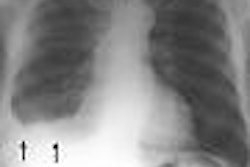SAN FRANCISCO - As with many other types of cancers, FDG-PET has demonstrated an ability to accurately assess oral cancer both pre- and post-treatment, according to a poster presentation Thursday at the American Association of Oral and Maxillofacial Surgeons (AAOMS) meeting.
Dr. Mikiko Nakamura, Ph.D., and colleagues used FDG-PET to "investigate the significance of tumor revascularization in oral squamous cell carcinoma (SCC) ... (and) examine the relationship between tumor angiogenesis and clinicopathological factors," the authors wrote.
The group is from the department of sensory and locomotor medicine at the University of Fukui School of Medicine in Fukui and the Hokkaido University Graduate School of Dental Medicine in Sapporo, both in Japan.
The study involved 20 patients who underwent FDG-PET imaging before and after two courses of intra-arterial chemoradiotherapy, as well as concomitant radiotherapy. The majority of tumors were located in the tongue, mandibular gingiva, and the floor of the mouth.
For the quantitative value of FDG uptake in the tumor, the researchers calculated the mean standardized uptake value (SUV) before and after treatment. They labeled microvessel structures obtained from pretreatment biopsies with an antibody (CD34) for immunohistochemical staining, and also calculated microvessel parameters as:
- Ratio of total microvessel number (TN) to the tumor area (TA)
- Ratio of the total microvessel perimeter (TP) to the TA
- Ratio of tumor tissue area more than 150 µm from microvessel
Pre- and post-treatment SUV was compared to the above parameters and clinicopathological factors. Statistical analysis was done using StatView 5.0 (BNN, Tokyo); a probability value of less than 0.05 was considered statistically significant.
According to the results, pretreatment PET scans demonstrated an increased uptake of FDG that corresponded to the primary lesion in all 20 cases. The post-SUV showed a significant decrease compared to pre-SUV. The regression analysis revealed statistical significances between TP:TA (p = 0.46) and TP:TA (p = 0.0206).
The pre-SUVs ranged from 4.07 to 26.10 mg/mL. The post-SUVs ranged from 1.12 to 8.32 mg/mL. The TP:TA ranged from 0.73 to 6.83 mm/mm2. The TN:TA ranged from 28.0 to 129.7 vessels/mm2. The hypoxic ratio ranged from 0.0% to 25.9%.
"Elevated glucose metabolism assessed by FDG-PET was correlated with reduced vascularization. Higher glucose mtabolism might reflect hypoxia," the group reported.
The poster builds on previous research by Nakamura and colleagues. In a study published in Oral Oncology, they looked at the value of FDG uptake in combination with histochemical expression of AgNORs for assessing residual tumors after intra-arterial chemoradiotherapy for SCC. They determined that tumors with higher post-SUVs and higher AgNORs scores had significantly higher incidences of residual viable tumor cells after chemoradiotherapy (February 2004, Vol. 40:2, pp. 190-198).
The results suggest that the combination of FDG-PET with AgNORs score is an excellent index for determining the optimal management of each patient following neoadjuvant chemoradiotherapy.
Because of the high cost, PET scans are not routinely performed on SCC patients at either institution, said co-author Dr. Yoshimasa Kitagawa in an interview with AuntMinnie.com. This investigation was done as part of an ongoing study funded by the Japanese government. Eventually, the group hopes to prove the value of FDG-PET imaging in these patients and win coverage from the insurance sector, he added.
This poster was judged the best international presentation by the AAOMS committee on continuing medical education and professional development.
By Shalmali Pal
AuntMinnie.com staff writer
September 30, 2004
Related Reading
Cisplatin plus radiation therapy improves head and neck cancer outcome, May 6, 2004
Atlas of Head and Neck Imaging: The Extracranial Head and Neck, March 13, 2004
Scintigraphic sentinal node mapping cost-effective for early head and neck cancer, October 31, 2003
Copyright © 2004 AuntMinnie.com




















